In the world of software development, choosing the right technology stack is a crucial decision that can have a significant impact on the success of a project. One of the popular options available to developers is the .NET framework, developed by Microsoft. With its powerful tools and libraries, .NET has been widely used by developers for years. However, like any technology, .NET has both advantages and disadvantages that developers should consider before choosing it for their projects.
About .Net Framework
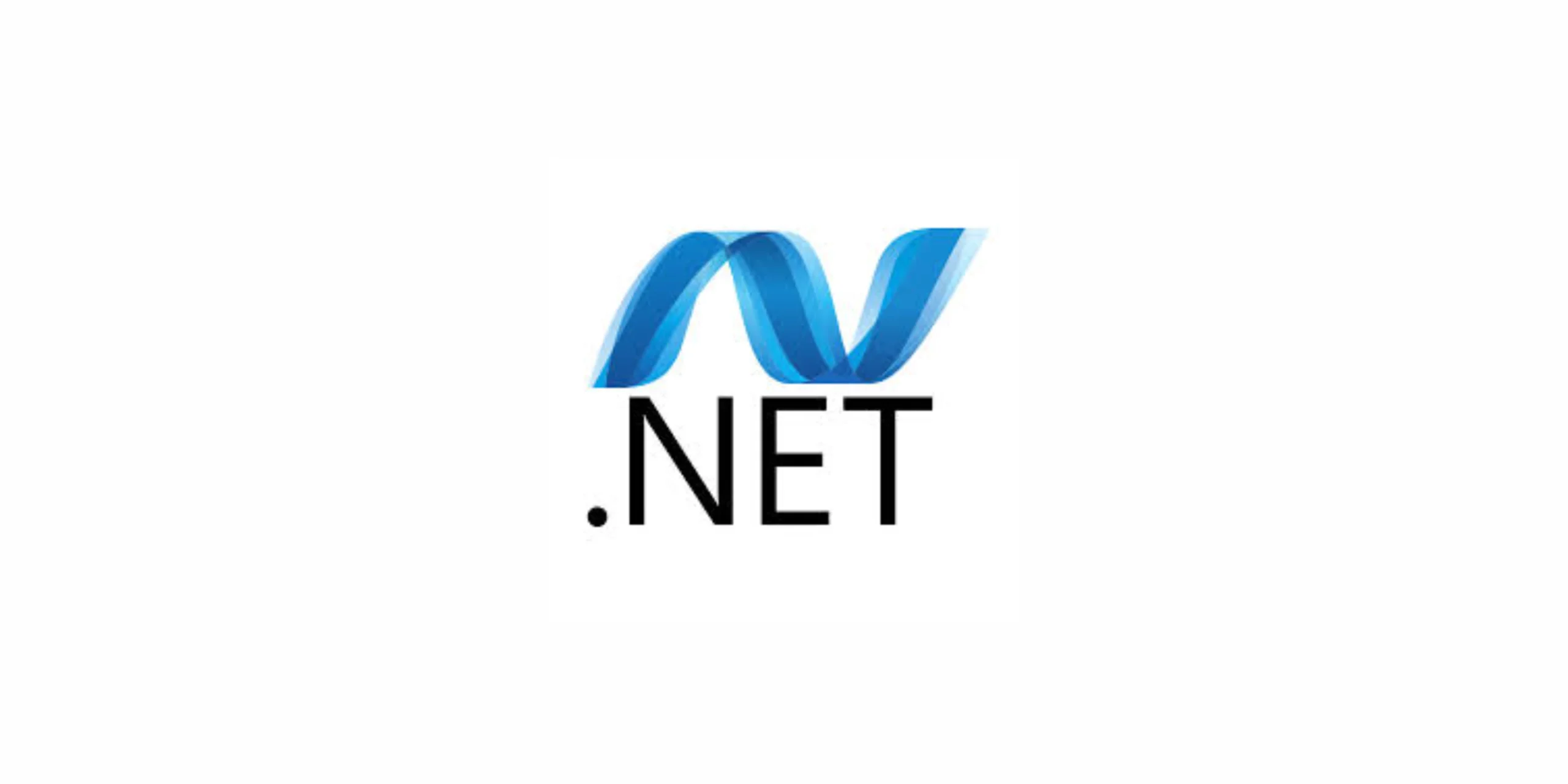
Developed by Microsoft, .NET (also known as .NET) is a framework that makes application development an easy task for developers. The framework supports the development as well as maintenance of modern-day applications and XML web services. .NET offers a highly consistent object-oriented programming environment to dedicated developers and is used to build applications that can run on multiple platforms.
One of the interesting things about the .NET framework is that it supports the creation of cross-platform applications that can run smoothly across server platforms such as Windows, Linux, and even MAC.
This framework can be used to design, develop, compile, build, and deploy a mobile application with its comprehensive range of compilers, code libraries, support programs, and APIs. The varied components of dotNET aid in the development of the customized project.
Over the years, .NET has undergone significant transformations, with the introduction of .NET Core and later .NET 5, which merged the capabilities of .NET Framework, .NET Core, and Xamarin into a unified platform. This evolution streamlined development processes, enhanced performance, and expanded support for modern application development scenarios.
Key Features of .Net Framework

1. Multi-language Support:
One of the defining features of .NET is its support for multiple programming languages. Developers can choose from languages like C#, VB.NET, F#, and more, based on their preferences and project requirements.
2. Common Language Runtime (CLR):
The CLR is the heart of the .NET Framework, providing services such as memory management, security, and exception handling. It ensures that .NET applications run efficiently and securely across different environments.
3. Framework Class Library (FCL):
The FCL is a comprehensive collection of reusable classes, interfaces, and types that simplify common programming tasks. It includes components for data access, networking, file I/O, and much more, reducing development time and effort.
4. ASP.NET for Web Development:
.NET offers ASP.NET, a powerful framework for building dynamic web applications. With features like MVC (Model-View-Controller) architecture, built-in authentication mechanisms, and support for modern web standards, ASP.NET remains a top choice for web developers.
5. Cross-Platform Capabilities:
With the advent of .NET Core and later versions, .NET has expanded its reach beyond Windows to support cross-platform development. Developers can build and deploy .NET applications on Windows, Linux, and macOS environments, fostering greater flexibility and scalability.
6. Integration with Visual Studio:
Microsoft’s Visual Studio IDE provides a rich development environment for .NET developers. It offers tools for code editing, debugging, testing, and deployment, empowering developers to create high-quality applications with ease.
.NET is widely used by developers for the creation of services and apps on multiple devices and operating systems. One of the aspects that make .NET stand out is the range of features offered by the application.
Reasons Businesses Choose to Use .NET
There are several advantages and disadvantages of the .NET framework. However, you must choose the .NET framework for the following reasons:

1. Platform Independent
Any application in any type of platform may be made using .NET. It supports all platforms; therefore, to put it simply, it is platform-independent. The mobile applications made with .NET will support various operating systems, including Android, iOS, Windows, and others. The amazing .NET offers you every solution imaginable when creating apps.
2. Better Performance
.NET produces a responsive result due to its high speed, just-in-time compilation, and improved performance. It takes a long time to respond. You can be happy with an excellent, adaptable procedure and a superior dynamic user experience.
3. Excellent User Interface and Architecture
A platform that is open source is NET. Utilize an IDE (Integrated Development Environment) that is efficient and dynamic when developing applications. You may create a compelling application using the best-in-class MVC (Model-View-Controller) architecture, an intuitive user interface, and superior UI controls.
4. Favored by Developers
Developers adore .NET because it is a cutting-edge, open-source programming platform. On the Stack Overflow Developer Survey, .NET has been named the most favored framework for three years (2019, 2020, and 2021).
In short, .NET speeds the development process by providing developers with reliable and user-friendly tools that enable them to tackle issues in any application without becoming bogged down by specific language constraints.
Advantages and Disadvantages of .Net Framework
The .NET Framework, developed by Microsoft, is a powerful software framework that supports the development and execution of various types of applications. It provides a comprehensive set of libraries and tools that enable developers to build robust and scalable applications for different platforms. However, like any technology, the .NET framework has its own set of advantages and disadvantages. Let’s explore them in more detail:
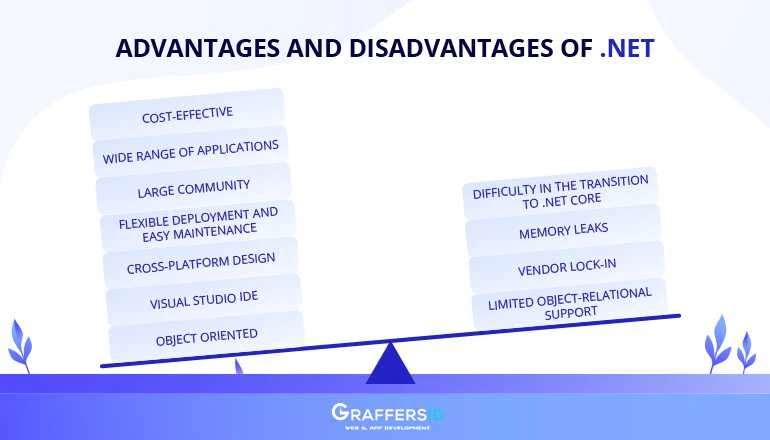
Advantages of the .NET Framework
Here are the key advantages of using the .NET framework in software development:
1. Object-Oriented Programming (OOP) Model
.NET is based on an Object-Oriented Programming (OOP) model, which simplifies application development by organizing code into reusable objects. This approach enhances code maintainability, reduces redundancy, and makes debugging and testing more efficient. OOP principles such as encapsulation, inheritance, and polymorphism improve software scalability and reusability, making the development process more streamlined.
2. Integrated Development Environment (IDE) – Visual Studio
Visual Studio, Microsoft’s IDE for .NET development, provides a comprehensive environment for building, debugging, and deploying applications. Key features include:
-
A single IDE for all .NET applications, supporting multiple programming languages like C#, F#, and VB.NET.
-
Integrated debugging tools that allow real-time issue detection and resolution.
-
A customizable interface to match developer preferences.
-
Access to a vast marketplace offering extensions for team collaboration, cloud development, and third-party integrations.
3. Cross-Platform Development with .NET Core
.NET Core, now part of .NET 5 and later versions, enables cross-platform development, allowing applications to run smoothly on Windows, Linux, and macOS. Developers can write code in C#, F#, or Visual Basic, and it will execute on any compatible operating system. This flexibility makes it easier to build applications that target multiple platforms while leveraging a single codebase.
4. Flexible Deployment and Easy Maintenance
.NET Core offers flexible deployment options:
-
Applications can be deployed as self-contained packages with all dependencies included.
-
.NET Core allows multiple versions to run side by side on the same machine, making it easier to manage different projects.
-
Deployment is simplified, often requiring just copying a folder, reducing operational complexity.
5. Support for a Wide Range of Applications
The .NET framework supports various application types, including:
-
Web applications using ASP.NET Core
-
Mobile applications with Xamarin
-
IoT and AI-driven solutions
-
Gaming applications using Unity and .NET-based engines
-
Enterprise-level cloud applications with Microsoft Azure integration
6. High Performance and Scalability
.NET is optimized for performance, with continuous improvements in each new release. Notable examples of high-performance .NET applications include:
-
Stack Overflow, which serves 5.3 million page views per day with just nine servers.
-
Raygun, a cloud monitoring application that improved API throughput by 2000% after migrating to .NET Core.
Paired with efficient database management and architecture, .NET is an excellent choice for scalable enterprise applications.
7. Cost-Effective Development
The .NET ecosystem offers cost advantages in several ways:
-
Free development tools, such as Visual Studio Community Edition.
-
Cloud hosting flexibility allows developers to choose cost-effective cloud providers.
-
Open-source components reduce licensing costs while ensuring high-quality development resources.
8. Large Developer Community and Support
.NET has a vast community of developers, ensuring comprehensive support, knowledge sharing, and rapid troubleshooting. According to Stack Overflow surveys, .NET consistently ranks among the top frameworks due to its reliability and developer trust.
9. Smooth Integration with the Microsoft Ecosystem
.NET seamlessly integrates with Microsoft tools and services, including:
-
SQL Server for database management
-
Azure cloud services for scalable application hosting
-
Office 365 APIs for business application development
This tight integration makes it easier for enterprises to build interconnected solutions.
10. Security and Reliability
.NET includes built-in security features, such as:
-
Code Access Security (CAS) to prevent unauthorized access.
-
Role-Based Security (RBS) for access control.
-
Automatic memory management using garbage collection to reduce memory leaks.
These security measures ensure robust application performance while protecting against threats.
11. Fast Development with Pre-Built Libraries
.NET provides a rich set of libraries and frameworks that accelerate development. Pre-built functionalities include:
-
File I/O operations
-
Database connectivity
-
Networking and web services support
Additionally, Visual Studio offers debugging, profiling, and testing tools that improve developer productivity.
12. Containerization Support for Modern Applications
.NET supports containerized applications using Docker and Kubernetes. This enables:
-
Efficient deployment and scaling in cloud environments.
-
Microservices architecture for modular application development.
Containerization improves application portability, reliability, and resource efficiency.
13. Machine Learning and AI Capabilities
With ML.NET, .NET provides machine learning and AI integration, allowing developers to:
-
Use pre-trained ML models.
-
Train custom models for AI-driven applications.
-
Enhance applications with intelligent data analysis and automation features.
14. Cloud-Native Development with Microsoft Azure
.NET is optimized for cloud-native development, with built-in support for:
-
Azure Functions for serverless computing.
-
Azure Blob Storage for scalable data storage.
-
Azure SQL Database for high-performance cloud-based database management.
These integrations enable developers to build cost-effective, scalable, and resilient applications.
Disadvantages of .NET
However, while it offers numerous advantages, it also has some drawbacks that developers and businesses should consider.
1. Vendor Lock-in
While .NET Core is open source, the entire .NET ecosystem is controlled by Microsoft. This means that businesses relying on .NET technology are dependent on Microsoft’s decisions regarding updates, licensing, and future development.
2. Memory Management Issues
Although .NET includes a garbage collector to handle memory management, developers still face challenges with memory leaks. If objects are not properly disposed of, applications can experience performance issues due to excessive memory consumption.
3. Steep Learning Curve
The extensive libraries and tools available in .NET can be overwhelming for beginners. Developers need to invest significant time in learning best practices, especially when transitioning between different versions like .NET Framework, .NET Core, and .NET 5+.
4. Deployment Complexity and Size
Applications built with .NET often require the installation of the runtime environment, increasing deployment complexity and the size of the application package. While .NET Core has mitigated this to some extent, deployment remains more complex compared to some other frameworks.
5. Difficulty in Transitioning to .NET Core
Many businesses use older .NET Framework versions, and migrating legacy applications to .NET Core or newer versions can be challenging. Compatibility issues and redevelopment costs can make the transition time-consuming and expensive.
6. Cross-Platform UI Development Challenges
While .NET supports cross-platform development for backend services, UI development across multiple platforms still requires additional frameworks like Xamarin.Forms, leading to inconsistencies in performance and design.
7. Limited Support for Some Open-Source Tools
Although .NET Core is open source, certain legacy components remain proprietary. This can create challenges for developers who prefer fully open-source development environments.
8. Community Fragmentation
The evolution of .NET through multiple versions (.NET Framework, .NET Core, .NET 5, etc.) has led to fragmentation, making it difficult for developers to find consistent resources and support for all versions.
Comparison of Advantages and Disadvantages of .NET
|
Category |
Advantages |
Disadvantages |
|
Development & Performance |
✅ Object-oriented programming (OOP) for maintainability & scalability. ✅ High performance with optimized execution. ✅ Pre-built libraries speed up development. |
❌ Limited Object-Relational Support in Entity Framework. ❌ Performance overhead in real-time systems. ❌ Steep learning curve for beginners. |
|
Cross-Platform & Compatibility |
✅ .NET Core enables cross-platform development. ✅ Works with cloud, IoT, AI, gaming, and enterprise applications. |
❌ Full .NET Framework is Windows-dependent. ❌ Transitioning older .NET apps to .NET Core is complex. ❌ UI consistency across platforms requires additional tools. |
|
Deployment & Maintenance |
✅ Flexible deployment with self-contained apps. ✅ Supports containerization & microservices. |
❌ Deployment requires runtime installation, increasing complexity. ❌ Containerization is harder compared to some other frameworks. |
|
Community & Ecosystem |
✅ Large developer community for support & troubleshooting. ✅ Cost-effective with free tools & open-source components. |
❌ Vendor lock-in with the Microsoft ecosystem. ❌ Community fragmentation due to multiple versions of .NET. |
|
Security & Third-Party Integration |
✅ Built-in security features like CAS & RBS. ✅ Seamless integration with Microsoft Azure & third-party tools. |
❌ Memory leak issues despite garbage collection. ❌ Some legacy components remain proprietary. |
Difference Between .NET Framework and .NET Core
.NET Framework and .NET Core are both software development platforms created by Microsoft, but they have some key differences:
|
Feature |
.NET Framework |
.NET Core (.NET 5 and later) |
|
Platform |
Windows-only |
Cross-platform (Windows, Linux, macOS) |
|
Performance |
Moderate |
High performance with optimized execution |
|
Deployment |
Requires full framework installation |
Can be deployed as a self-contained app |
|
Microservices & Containers |
Limited support |
Fully supports Docker & Kubernetes |
|
Future Support |
Legacy technology |
Actively developed and recommended |
Comparison of .NET Framework with Other Web Development Frameworks
The .NET framework is a popular web development framework that is often compared to other frameworks such as Java, Ruby on Rails, and Node.js.
1. .NET vs Java
-
.NET: Best suited for Windows-based applications, with seamless integration into Microsoft services.
-
Java: More widely adopted for cross-platform development with strong open-source support.
-
Performance: Both offer high performance and scalability, but .NET has better integration with Azure for cloud apps.
2. .NET vs Ruby on Rails
-
.NET: More powerful and widely adopted in enterprise applications.
-
Ruby on Rails: More developer-friendly for rapid web development but lacks enterprise-grade robustness.
-
Community & Resources: .NET has a larger ecosystem and more extensive support.
3. .NET vs Node.js
-
.NET: More stable and feature-rich, with built-in security mechanisms.
-
Node.js: Asynchronous, event-driven, and lightweight, making it ideal for real-time applications.
-
Pre-Built Libraries: .NET provides more extensive pre-built components, reducing development effort.
Limitations of the .NET Framework
The .NET framework is a powerful web development framework, but it has some limitations:
- Windows-Centric: Although .NET Core is cross-platform, the .NET Framework is primarily Windows-based.
- Memory Consumption: Large applications can have high memory usage.
- Learning Curve: Developers new to .NET may find it complex.
- Limited Open-Source Libraries: Compared to Java and Python, open-source support is less extensive.
- Vendor Lock-in: Heavy reliance on Microsoft technologies may not suit all businesses.
It’s important to keep in mind that these limitations may or may not affect your specific project or use case. Before deciding on the framework to use, it’s important to carefully weigh the advantages and limitations of the .NET framework against the specific requirements and needs of your project.
Technologies Before .NET and Their Drawbacks
Before .NET, developers used technologies such as:
|
Technology |
Major Drawbacks |
|
ActiveX & COM |
Poor interoperability, complex deployment |
|
Visual Basic |
Limited scalability for enterprise applications |
|
ASP (Active Server Pages) |
Lacked modern security and performance features |
|
MFC (Microsoft Foundation Class) |
Steep learning curve and outdated methodologies |
|
J++ |
Proprietary Java variant with limited adoption |
How .NET Solved These Issues
-
Unified programming model with multi-language support.
-
Improved scalability and security.
-
Enhanced support for web, mobile, and cloud applications.
Popular Applications Built with .NET
The versatility of .NET allows businesses to develop applications across diverse industries. Some of the most common applications include:
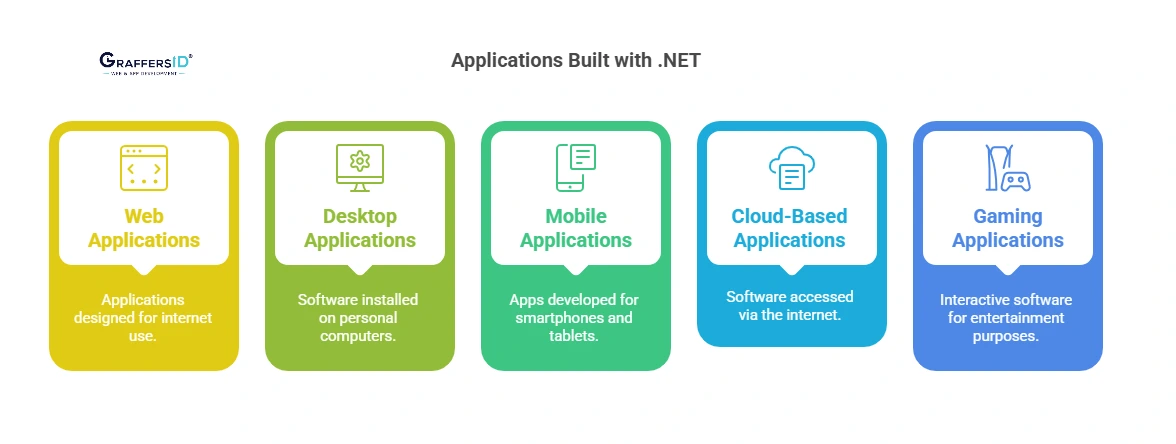
1. Web Applications
ASP.NET is widely used for creating dynamic, high-performance web applications. It provides seamless integration with modern front-end frameworks and cloud-based solutions.
2. Desktop Applications
Technologies like Windows Forms and WPF enable the development of robust, user-friendly desktop applications optimized for the Windows ecosystem.
3. Mobile Applications
With .NET MAUI (formerly Xamarin), businesses can develop cross-platform mobile applications for iOS and Android using a shared C# codebase.
4. Cloud-Based Applications
.NET is highly compatible with Microsoft Azure, offering seamless cloud application development with built-in security, scalability, and integration with AI services.
5. Gaming Applications
.NET is widely used in game development, particularly with Unity, one of the most popular game engines that supports C# scripting.
Best Practices for .NET Development in 2025
Adhering to best practices ensures that .NET applications remain scalable, maintainable, and secure. Here are some key principles to follow:

1. Choose the Right .NET Version
Microsoft regularly updates the .NET framework, releasing new versions with improvements and features. It’s essential to select the appropriate version of .NET for your project. Consider factors like compatibility, performance, and the availability of required libraries. Staying up-to-date with the latest version can also provide security and performance benefits.
2. Follow SOLID Principles
The SOLID principles (Single Responsibility, Open/Closed, Liskov Substitution, Interface Segregation, and Dependency Inversion) are fundamental principles of object-oriented design. Adhering to these principles promotes clean, maintainable, and scalable code. They encourage the separation of concerns and reduce code complexity.
3. Use Dependency Injection
Dependency Injection (DI) is a technique that promotes loose coupling between components in your application. It allows you to inject dependencies, such as services or objects, into classes rather than hard-coding them. This makes your code more testable, flexible, and easier to maintain.
4. Implement Modern Design Patterns
Design patterns, such as Factory, Singleton, and Repository, provide proven solutions to common software design problems. Leveraging these patterns can improve code organization and maintainability. .NET developers can benefit from design pattern libraries and frameworks like Entity Framework for the Repository pattern.
5. Optimize Database Performance
Efficient database access is crucial for the performance of .NET applications. Use an Object-Relational Mapping (ORM) framework like Entity Framework Core to abstract database interactions. Employ techniques like lazy loading, batching, and caching to minimize database round trips and improve query performance.
6. Write Clean, Readable Code
Maintainable code is essential for long-term project success. Write clean, well-documented, and readable code. Use meaningful variable and function names, adhere to consistent coding conventions, and comment your code to make it easier for other developers to understand and maintain.
7. Ensure Robust Error Handling
Effective error handling is critical to providing a smooth user experience and diagnosing issues in production. Use structured exception handling in your code and log errors properly. Implement custom error messages and consider using logging libraries like Serilog or NLog to track application errors.
8. Prioritize Security Best Practices
Security should be a top priority in .NET development. Protect your application against common threats like SQL injection, cross-site scripting (XSS), and cross-site request forgery (CSRF). Follow security best practices, validate user inputs, and use encryption for sensitive data.
9. Use Asynchronous Programming
Asynchronous programming is essential for building responsive and scalable .NET applications. Utilize asynchronous methods and the async/await keywords to improve the responsiveness of your applications, especially in web and mobile scenarios.
10. Implement Continuous Integration & Deployment (CI/CD)
CI/CD pipelines automate the build, testing, and deployment processes, reducing human error and ensuring that your application is always in a deployable state. Popular CI/CD tools like Azure DevOps and Jenkins integrate seamlessly with .NET projects.
Evolution of the .NET Framework
.NET has continuously evolved to provide better performance, cross-platform support, and modern development capabilities. Here’s an overview of its key versions:
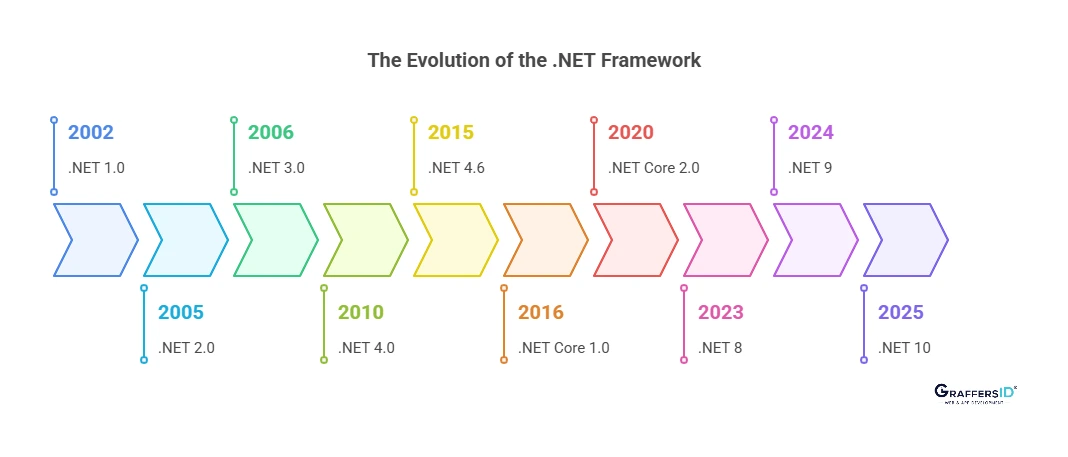
.NET Framework 1.0 (2002)
-
The first version of the .NET Framework was released in February 2002.
-
Introduced a managed execution environment, the Common Language Runtime (CLR), and the Base Class Library (BCL).
-
Supported ASP.NET for web development and Windows Forms for desktop applications.
-
Provided interoperability with COM (Component Object Model) components.
.NET Framework 1.1 (2003)
-
Released in April 2003 with minor updates and bug fixes.
-
Improved security features and better support for web applications.
-
Introduced built-in support for mobile applications with ASP.NET Mobile Controls.
.NET Framework 2.0 (2005)
-
Released in November 2005 with major enhancements.
-
Introduced generics, partial classes, anonymous methods, and nullable value types.
-
Improved ADO.NET for better database access.
-
Enhanced ASP.NET with support for web parts and master pages.
.NET Framework 3.0 (2006)
-
Released in November 2006 as an extension of .NET Framework 2.0.
-
Introduced Windows Presentation Foundation (WPF) for rich UI development.
-
Added Windows Communication Foundation (WCF) for better service-oriented architecture.
-
Introduced Windows Workflow Foundation (WF) and Windows CardSpace for identity management.
.NET Framework 3.5 (2007)
-
Released in November 2007 with further improvements.
-
Introduced Language Integrated Query (LINQ) for smooth data querying.
-
Enhanced ASP.NET with AJAX support.
-
Improved WPF, WCF, and WF features.
.NET Framework 4.0 (2010)
-
Released in April 2010 with significant performance enhancements.
-
Introduced the Dynamic Language Runtime (DLR) to support dynamic programming languages.
-
Improved parallel and multi-threading support.
-
Enhanced garbage collection and memory management.
.NET Framework 4.5 (2012)
-
Released in August 2012, focusing on modern application development.
-
Introduced asynchronous programming with the “async” and “await” keywords.
-
Improved performance and startup times for applications.
-
Enhanced support for Windows Store apps and cloud-based applications.
.NET Framework 4.6 (2015)
-
Released in July 2015, focusing on stability and performance.
-
Introduced the RyuJIT compiler for better JIT compilation.
-
Improved cryptography APIs and security features.
-
Enhanced debugging and diagnostic tools.
Shift to .NET Core and Beyond
.NET Core 1.0 (2016)
-
Released in June 2016 as a cross-platform, open-source framework.
-
Supported Windows, macOS, and Linux, enabling developers to build applications across different operating systems.
-
Modular and lightweight compared to the traditional .NET Framework.
-
Introduced ASP.NET Core for high-performance web development.
.NET Core 2.0 and 3.0 (2017-2019)
-
Brought significant performance improvements and more APIs from the .NET Framework.
-
Enhanced cross-platform capabilities.
-
.NET Core 3.0 introduced support for Windows Forms and WPF applications on Windows.
.NET 5 (2020)
-
Released in November 2020, marking the unification of .NET Core and .NET Framework.
-
A single platform for building web, desktop, cloud, mobile, gaming, IoT, and AI applications.
-
Improved performance, garbage collection, and networking APIs.
.NET 6 (2021) and .NET 7 (2022)
-
.NET 6 was released in November 2021 as a Long-Term Support (LTS) version.
-
Introduced performance optimizations and hot reload features for better developer productivity.
-
.NET 7, released in November 2022, continued enhancing speed, security, and cloud capabilities.
.NET 8 (2023)
-
Released in November 2023, bringing improved security, cloud-native capabilities, and AI-driven development features.
-
Introduced performance enhancements, AI integration, cloud-native development, and security updates.
-
Enhanced minimal APIs for building high-performance applications with less boilerplate code.
.NET 9 (2024)
-
Released on November 12, 2024, introducing major enhancements.
-
Cloud-Native Focus: Enhanced support for cloud-native application development.
-
Performance Improvements: Optimized runtime and libraries for faster execution and reduced memory consumption.
-
Native AOT Compilation: Improved Ahead-of-Time (AOT) compilation, reducing application footprint and startup time.
-
Enhanced Diagnostics: New diagnostic tools for better application monitoring and troubleshooting.
-
C# 12 Integration: Added features from C# 12 for improved developer productivity and readability.
.NET 10 and Beyond
-
Expected to be released in November 2025 as a Long-Term Support (LTS) version.
-
Predicted advancements in AI integration, cross-platform development, and security enhancements.
-
Continued focus on cloud-native solutions and improved developer experiences.
The .NET platform has undergone a remarkable transformation since its inception, evolving from a Windows-centric framework to a versatile, open-source, cross-platform development environment. With each iteration, .NET has introduced features that empower developers to build high-performance, secure, and scalable applications across various domains. As we move forward, the .NET ecosystem is poised to embrace emerging technologies and development paradigms, ensuring its relevance and utility in the ever-changing landscape of software development.
Read More: Should You Migrate from .NET Framework to .NET Core?
How to Install .NET Framework on Windows?
If you’re looking to install .NET on your Windows system in 2025, follow this updated guide to ensure a smooth installation.
Before installing the .NET Framework, check the system requirements for the specific version you intend to install. The latest release in 2025 is .NET 9, which brings enhanced performance, cloud-native capabilities, and AI-driven development tools.
Step 1: Check Existing .NET Versions
Before proceeding with the installation, check if you already have a version of the .NET Framework installed on your system. You can do this by navigating to the “Control Panel” and selecting “Programs and Features.” Look for any entries related to the .NET Framework.
Step 2: Download the .NET Installer
Visit the official Microsoft website or use a reliable source to download the .NET Framework installer. Ensure that you download the version compatible with your operating system. As of the last update, you can find the installer for .NET 6 on the official .NET download page.
Step 3: Run the Installer
Locate the downloaded installer file and double-click on it to run the installation wizard. Follow the on-screen instructions to proceed through the installation process. The wizard will guide you through selecting the installation options, such as the installation location and the components to be installed.
Step 4: Complete the Installation
Once you’ve configured the installation options, click the “Install” button to initiate the installation process. The installer will now download and install the necessary files for the .NET Framework on your Windows system. This may take some time, depending on your internet connection speed and system performance.
Step 4: Verify Installation
After the installation is complete, it’s essential to verify that the .NET Framework has been successfully installed. You can do this by running a simple command in the command prompt or checking the installed programs list in the “Control Panel.”
Congratulations! You’ve successfully installed .NET on your Windows system.
What’s New in .NET 9? (2025 Update)
The release of .NET 9 introduces groundbreaking improvements, enhancing performance, scalability, and AI-driven development. Key highlights include:

1. Advanced Blazor Capabilities for Cross-Platform Development
-
Expanded support for Blazor Hybrid applications, enabling seamless integration with native mobile and desktop environments.
-
Improved performance and enhanced UI rendering for a smoother user experience.
-
Better interop with JavaScript and native device APIs for hybrid applications.
2. Optimized Minimal APIs & RESTful Services
-
Further streamlined API development with enhanced routing and request handling.
-
Improved built-in authentication and security mechanisms for web services.
-
Optimized serialization and deserialization for faster API response times.
3. Next-Generation Hot Reload & Live Debugging
-
Faster, more efficient Hot Reload support across all application types, including Blazor, MAUI, and ASP.NET Core.
-
Enhanced live debugging tools for real-time application updates without restarting.
-
Improved compatibility with cloud-based CI/CD pipelines.
4. AI & Machine Learning Integration
-
Azure AI Integration: Easy access to AI models directly within .NET applications.
-
C# 12 Enhancements: AI-powered code optimizations and real-time refactoring suggestions.
-
Intelligent Code Reviews: AI-assisted debugging and performance monitoring.
5. Enhanced Microservices & Cloud-Native Support
-
Stronger Kubernetes Integration: Improved orchestration and service discovery.
-
Optimized Containerization: Faster startup times and lower resource consumption in cloud environments.
-
Automatic Scaling: Enhanced auto-scaling capabilities for microservices on Azure and AWS.
6. Security & Performance Improvements
-
Native AOT Enhancements: Further reduced startup time and memory consumption.
-
Zero Trust Security Model: Enhanced authentication and authorization for cloud applications.
-
Quantum-Ready Cryptography: Improved security algorithms to future-proof applications.
.NET 9 continues to redefine modern application development with a strong focus on performance, AI, and cloud-native solutions. Developers can expect faster workflows, improved security, and deeper AI-driven automation, making .NET 9 an essential upgrade for enterprise and cloud-based applications.
Future of .NET (2025 & Beyond)
The future of .NET remains bright as Microsoft continues to push the boundaries of innovation, enhancing performance, AI-driven development, and cross-platform capabilities. Here’s what’s expected in .NET 10 and beyond:
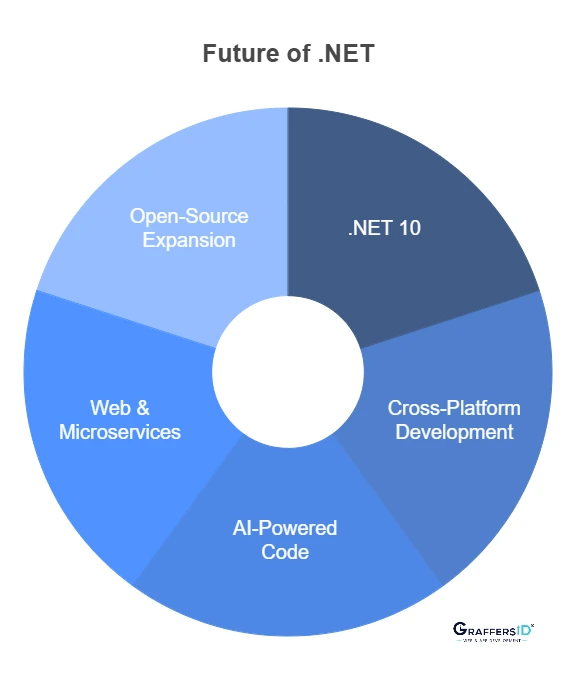
1. .NET 10: The Next-Generation LTS Release
-
Expected in November 2026 as a Long-Term Support (LTS) release.
-
Performance Boosts: Further enhancements in Just-In-Time (JIT) and Ahead-Of-Time (AOT) compilation for optimized execution.
-
AI-Driven Development: Deeper integration with Azure OpenAI for real-time code suggestions and automation.
-
Cloud-Native Enhancements: Improved serverless computing and containerized application support.
2. True Cross-Platform Development with .NET
-
.NET MAUI Expansion: More stability, better performance, and deeper platform integrations for iOS, Android, Windows, and macOS.
-
WebAssembly & Blazor: Further improvements to WebAssembly for running .NET applications directly in the browser without plugins.
-
Universal .NET Runtime: A single, fully optimized runtime for all .NET applications.
3. AI-Powered Code & Automation
-
AI-Powered Debugging: Advanced machine-learning models for automatic bug detection and fixes.
-
Smarter GitHub Copilot: AI-generated unit tests, code optimizations, and predictive analytics.
-
Automated Performance Monitoring: AI-driven profiling tools for analyzing and improving application efficiency.
4. Enhanced Web & Microservices Architecture
-
ASP.NET Core 10: Faster, more lightweight web frameworks with improved scalability.
-
Serverless & Event-Driven Computing: Native support for AWS Lambda and Azure Functions.
-
Zero Trust Security Model: Built-in security updates to support evolving cybersecurity threats.
5. Open-Source & Community Expansion
-
More Open-Source Contributions: Expanded collaboration between Microsoft and the developer community.
-
No-Code & Low-Code Innovations: Simplified development tools for non-technical users.
-
Edge Computing & IoT Support: Better integration with edge devices for real-time processing.
Security Practices and Features in .NET (2025 Update)
.NET remains one of the most robust frameworks for building secure applications. However, ensuring security requires integrating best practices throughout the software development lifecycle—from design to deployment. In this post, we’ll explore essential security practices and built-in capabilities in .NET that developers should leverage in 2025.
1. Authentication and Authorization
Securing an application starts with properly authenticating users and managing their access to resources. .NET simplifies authentication and authorization through various built-in features:
-
ASP.NET Identity: A comprehensive membership system for handling user login, registration, and profile management. It supports external OAuth providers like Google, Facebook, and Microsoft.
-
Role-based Authorization: Restrict access to controllers and actions using [Authorize] and [RequiredRole] attributes.
-
Claims-based Authorization: Allows fine-grained control by attaching user identity information to access tokens.
-
OAuth and OpenID Connect: Implement secure authentication flows using libraries like Microsoft.AspNetCore.Authentication.JwtBearer and IdentityServer.
2. Managing Sensitive Data
Data security is critical in any application. Use the following techniques to protect sensitive information:
-
Encrypt sensitive database fields using SQL Server encryption or third-party libraries.
-
Store secrets securely with Azure Key Vault instead of hardcoding them.
-
Hash passwords using BCrypt or Argon2 with multiple iterations and a salt for enhanced security.
-
Prevent SQL injection by parameterizing SQL queries and using ORM frameworks like Entity Framework Core.
3. Securing Communication Channels
Ensuring secure communication between clients, servers, and APIs is crucial. .NET provides built-in capabilities to help:
-
Enforce HTTPS with TLS 1.3 for secure data transmission.
-
Implement proper certificate validation to prevent man-in-the-middle (MITM) attacks.
-
Use cryptographic libraries like System.Security.Cryptography for encryption, hashing, and certificates.
4. Built-in Defenses Against Common Attacks
.NET applications can be hardened against common attacks using:
-
Input validation via data annotations to prevent XSS and SQL injection.
-
Cross-Site Request Forgery (CSRF) protection using the [ValidateAntiForgeryToken] attribute.
-
Output sanitization before rendering user-generated content to prevent XSS attacks.
-
Rate limiting and throttling to prevent abuse and DDoS attacks.
Other Security Best Practices
-
Conduct regular security audits and penetration testing.
-
Use logging and monitoring with tools like Application Insights and Serilog.
-
Follow the principle of least privilege (PoLP) for API keys and user roles.
-
Enable automatic security updates for .NET libraries and dependencies.
Is .NET Suitable for Mobile Applications in 2025?
While the traditional .NET Framework was not optimized for mobile development, Microsoft has enhanced .NET’s capabilities with:
-
.NET MAUI (Multi-platform App UI): The successor to Xamarin, allowing developers to build cross-platform mobile apps using .NET.
-
Blazor Hybrid Apps: Build web-based mobile applications using .NET and WebAssembly.
.NET MAUI and Blazor now provide robust tools for developing native and hybrid mobile apps efficiently.
Read More: Node.js vs. Traditional Back-End Technologies: A Detailed Comparison
How to Integrate Third-Party Libraries and APIs in .NET?
Integrating third-party libraries and APIs enhances functionality while reducing development time. Follow these steps for seamless integration:
Understanding Third-Party Libraries and APIs
Before diving into the integration process, let’s clarify what third-party libraries and APIs are:
Using NuGet Packages
-
Open Visual Studio and your .NET project.
-
Manage NuGet Packages: Right-click your project, select “Manage NuGet Packages”, and browse for the required package.
-
Install and Import: Click “Install”, then import the library in your code using “using” statements.
Manual Integration
-
Download the library from its official source (GitHub, vendor website, etc.).
-
Add it to your project: Right-click on your project in Visual Studio, select “Add Reference”, and browse for the DLL.
-
Configure dependencies as per the documentation.
Integrating External APIs
-
Obtain API credentials from the provider’s developer portal.
-
Read API documentation to understand endpoints and authentication.
-
Use HttpClient to make secure API requests.
-
Implement error handling for API failures and rate limits.
-
Store API keys securely in environment variables or Azure Key Vault.
Best Practices and Considerations
-
Version Compatibility: Ensure that the libraries and APIs you integrate are compatible with your .NET framework or runtime version to avoid compatibility issues.
-
Error Handling: Implement robust error-handling mechanisms to handle exceptions, network errors, and API response errors gracefully.
-
Security: Follow security best practices such as secure storage of API credentials, HTTPS usage for API calls, input validation, and data encryption where necessary.
-
Testing: Thoroughly test the integration of third-party libraries and APIs in different environments (development, staging, production) to identify and fix any issues early.
Best Practices for Optimizing Performance in .NET Applications
Performance optimization is a crucial aspect of developing robust and efficient .NET applications. Whether you’re working on a web application, desktop software, or a mobile app, ensuring optimal performance can significantly enhance user experience and overall satisfaction. Here are the latest best practices:

1. Use Efficient Data Structures and Algorithms
Choosing the right data structures and algorithms can have a profound impact on the performance of your .NET application. For example, using HashSet<T> instead of List<T> for collections where duplicate elements are not allowed can lead to faster lookup times. Similarly, opting for algorithms with lower time complexity (e.g., O(log n) instead of O(n^2)) can improve overall performance, especially when dealing with large datasets.
2. Minimize Database Roundtrips
Database access is often a bottleneck in application performance. Minimize database roundtrips by using techniques like batching multiple queries into a single request, using stored procedures for frequently executed operations, and leveraging caching mechanisms to reduce repetitive database calls. Entity Framework Core’s Include method and lazy loading can also be optimized to fetch only necessary data, thereby reducing overhead.
3. Implement Asynchronous Programming
Asynchronous programming is a powerful technique to improve responsiveness and scalability in .NET applications. Use async and await keywords along with Task-based asynchronous patterns (TAP) to perform I/O-bound operations asynchronously. This prevents blocking the main thread and allows the application to handle more concurrent requests efficiently.
4. Reduce Memory Usage
Excessive memory usage can lead to performance degradation and even cause out-of-memory exceptions. Monitor and optimize memory usage by identifying and eliminating memory leaks, disposing of unmanaged resources properly (e.g., using IDisposable and finalizers), and implementing efficient data caching strategies (e.g., using MemoryCache or distributed caching solutions like Redis).
5. Profile and Benchmark Code
Profiling and benchmarking are essential tools for identifying performance bottlenecks and measuring improvements. Use profilers like JetBrains dotTrace, Microsoft’s PerfView, or Visual Studio’s Performance Profiler to analyze CPU, memory, and I/O usage. Benchmarking libraries like BenchmarkDotNet can help compare the performance of different code implementations and identify areas for optimization.
6. Enable Just-In-Time (JIT) Compilation Optimization
.NET runtime provides Just-In-Time compilation to convert IL (Intermediate Language) code into native machine code. Enable JIT compilation optimizations by targeting the appropriate CPU architecture (e.g., x86 or x64), using compiler directives like MethodImplOptions.AggressiveInlining for performance-critical methods and optimizing hot paths in your codebase.
7. Utilize Caching and Compression
Caching frequently accessed data in memory can reduce latency and improve response times. Use caching mechanisms like in-process caching (e.g., using MemoryCache) or distributed caching (e.g., Redis or Azure Cache for Redis) based on your application’s scalability requirements. Additionally, consider using data compression techniques (e.g., gzip or Brotli) for transmitting large payloads over the network, reducing bandwidth consumption and improving performance.
8. Leverage Parallel Processing
Harness the power of parallelism and multithreading to execute CPU-bound tasks concurrently and utilize available CPU cores efficiently. Use Parallel class, Task Parallel Library (TPL), or asynchronous programming models to parallelize computations, avoid thread contention, and improve overall throughput in multi-core environments.
.NET continues to evolve, offering strong security, mobile compatibility, smooth API integration, and high performance. By following these updated security and optimization best practices, developers can build secure, scalable, and efficient .NET applications in 2025.
Conclusion
.NET has evolved into a powerful and versatile framework, making it a top choice for developers worldwide. With the latest advancements in .NET 9, developers can leverage improved performance, security, and cross-platform capabilities.
To maximize the potential of .NET in 2025, developers should follow best practices like efficient code structuring, performance optimization, and enhanced security implementations. As .NET continues to evolve beyond 2025, it will likely integrate more AI-driven automation and cloud-native capabilities, further solidifying its relevance in modern software development.
GraffersID provides skilled remote developers to help you build high-performing, scalable applications.





